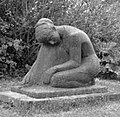Ernst Heller (sculptor)
Ernst Heller (born March 25, 1894 in Eglisau , Canton of Zurich ; † August 10, 1972 ibid) was a Swiss sculptor from the inter and post-war period .
Life
After a broken teacher training course, Heller first studied painting at the Böcklin School in Zurich. Significantly supported by two patrons , he continued his art studies at the school of Arthur Lewin-Funcke under Martin Brandenburg and Lovis Corinth at the end of 1913 . In 1915 he made the acquaintance of his future first wife, the German painter Ilse Lazard . Back in Switzerland, he switched to sculpture and completed a traineeship with the Zurich sculptor Hermann Haller until 1919 . Already in this phase he succeeded in 1917 with the bust Portrait of Ferdinand Hodler ( Kunsthaus Zürich ) and the sculpture of fallen works, intended as a war memorial . A portrait bust of the painter friend Cuno Amiet was created a year later.
In 1918 he married Ilse Lazard . In late 1919, the couple moved to Rome to study ancient and classical Mediterranean art. With his large-scale sculpture L'offerta or Das Gebet (later Adorant ) he represented the Swiss sculptors at the Biennale in Rome in 1923/24 together with Hermann Haller . The work can be viewed today in the Villa Alma public park in Männedorf ZH. There is uncertainty about the exact time when an expressive series of small erotic reliefs was created.
In November 1927 the couple moved into new premises in Paris- Montparnasse . With the exception of the boy with a carnation (Kilchberg parish hall), Private acquired his work in the subsequent period. The monumentally designed swimmer was prominently placed in front of the main portal of the old canton school at the large, international plastic exhibition in Zurich in summer 1931. Today he is in his home town of Eglisau. After Ilse Lazard's death in 1934, he married his former student, the sculptor Maja Klauser (1912–2000). In 1938, they moved into their new studio in Eglisau, Switzerland.
As one of the first in a long series of works in public space, the Green Heinrich Fountain in Glattfelden was inaugurated in 1941 . In the post-war period, he was able to design and implement multiple groups of sculptures, fountains, etc. specifically for a situation, according to his inclination, for example the group of children playing at the Arbon town hall in 1945 . In 1953 the Saurerdenkmal standing workers there , in the same year the cemetery sculpture Kneeling Woman with Raised Forearms in Dübendorf , a year later in Bülach the fountain figure The Good Shepherd , in 1961 in Embrach the fountain figure Seated Girl, head in hand , In 1961 the heptagonal creation fountain in Eglisau , in 1965 the fountain group standing youth with flute, girl listening at the Uster district hospital .
Heller always worked figuratively. His closeness to nature was also expressed in a variety of animal sculptures. He was impressed by the monumentality of the cattle in his parents' stable, which he interpreted again and again. But cats, deer, roe deer, owls and ravens also inspired him. In the post-war period he also captured the light and nature of his surroundings in numerous watercolors. He cultivated friendships with the sculptors Karl Geiser and Heinrich Spörri, the painters Cuno Amiet, Johann von Tscharner , Max Hunziker , Max Gubler , Ossip Lubitsch and many others.
Many of the later works were created in collaboration with his wife Maja Heller-Klauser, although he rarely mentioned this. This dual authorship is specifically noted for the group of three terracotta reliefs in the Eglisau parish hall: voters, bridal couple, grape harvest. It is clearly proven that the aforementioned sculpture of a seated girl is based on a design by the artist.
Works
literature
- Maja Heller: Ernst Heller 1894–1972 life and work . Eglisau 1974. (published on the occasion of the memorial exhibition, ibid.)
- Matthias Heller: Ilse Heller-Lazard 1884–1934, In the penumbra of time. With a catalog of works and an afterword by Matthias Fischer. Verlag Elfundzehn, Eglisau 2009, ISBN 978-3-905769-12-8 .
- Eduard Plüss, Hans Christoph von Tavel: Artist Lexicon of Switzerland 20th century. Volume I, 1958 (works, exhib., Lit.) supplement 1967.
- Matthias Heller, Renate Treydel: Heller, Ernst . In: General Artist Lexicon . The visual artists of all times and peoples (AKL). Volume 71, de Gruyter, Berlin 2011, ISBN 978-3-11-023176-2 , p. 345.
- Nello Jacometti: Têtes de Montparnasse. Paris 1933.
- Hans Trog : The sculptor Ernst Heller In: Architecture and Art , Vol. 13, 1926, pp. 308-310
Web links
- Heller, Ernst. In: Sikart (status: 2011), accessed on May 30, 2016.
- Ernst Heller In: E-Periodica
- Erwin Poeschel: Ernst Heller In: E-Periodica
- Works by a local sculptor for the exhibition on Ernst Heller, on the website of the municipality of Eglisau, archive version from November 4, 2016
| personal data | |
|---|---|
| SURNAME | Heller, Ernst |
| BRIEF DESCRIPTION | Swiss sculptor |
| DATE OF BIRTH | March 25, 1894 |
| PLACE OF BIRTH | Eglisau |
| DATE OF DEATH | August 10, 1972 |
| Place of death | Eglisau |

